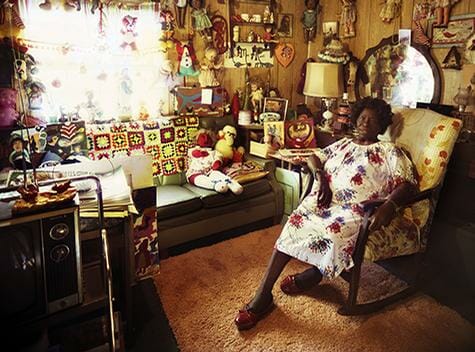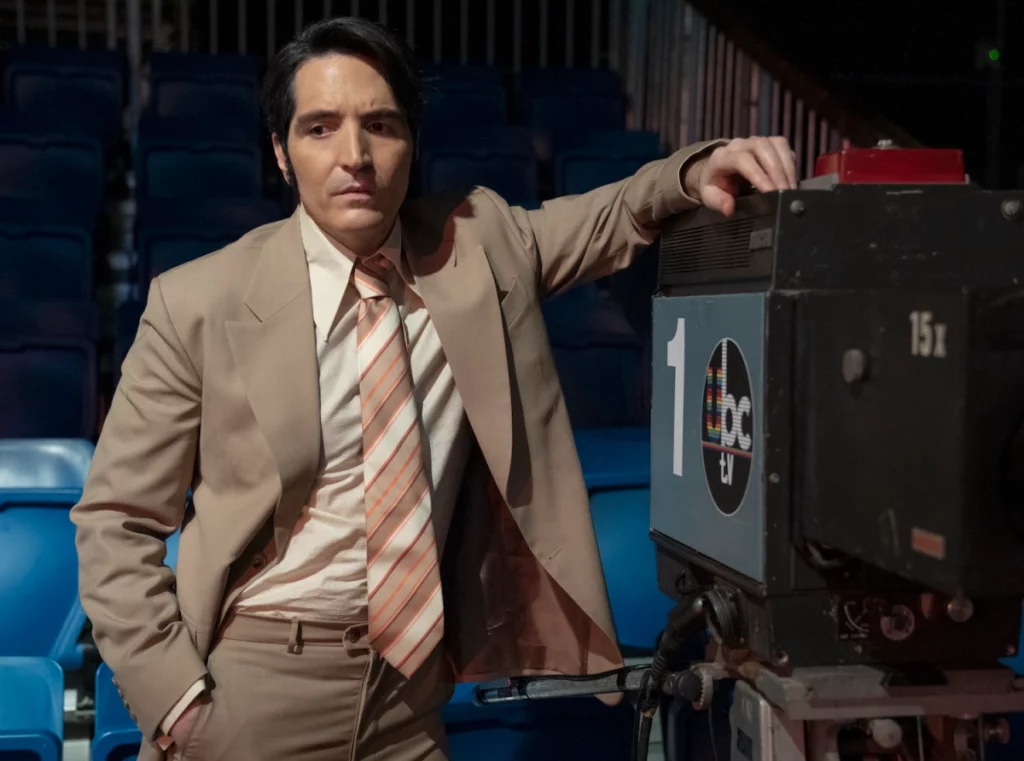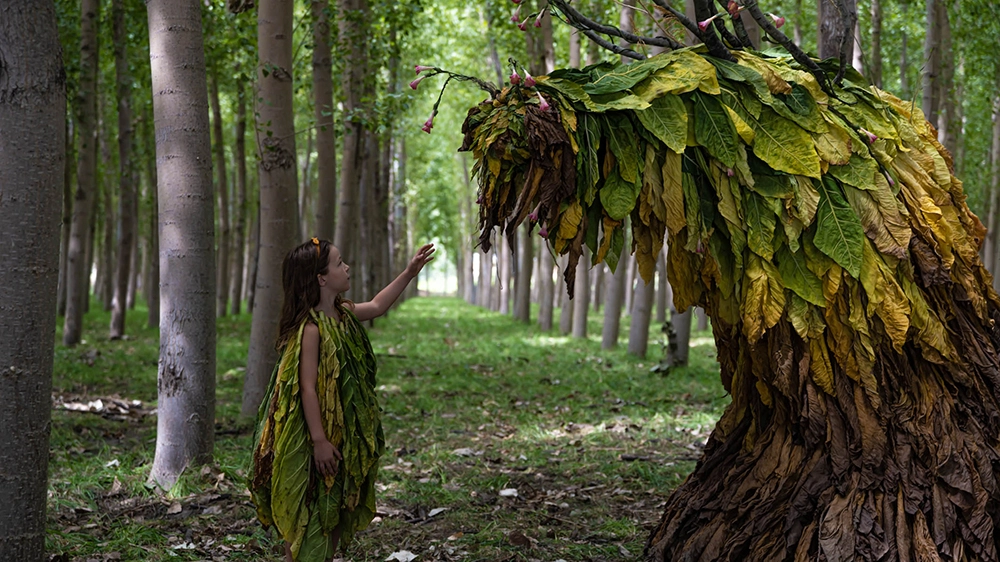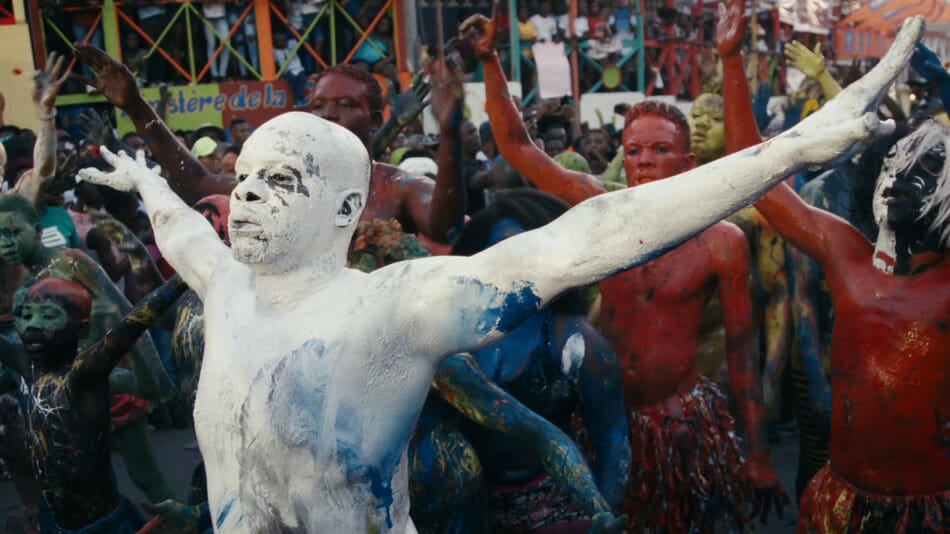Our final SXSW 2023 dispatch features a diverse selection of documentaries and features focusing on the search for a sense of place in a chaotic world.
The title of Petter Ringbom and Marquise Stillwell’s dazzling documentary, The World Is Not My Own, could be the epigraph for this year’s South by Southwest Film Festival. Each film I saw was about people trying to find their place in the material or metaphysical world. They are about the things we share and reject in our societies. They are about the spirits and forces that live amongst us. We come into an already-made world organized by institutions. If you’re lucky, you’ll find your fit. But for many of the artists behind and within these films, it’s easier to make a world of their own.
Ringbom and Stillwells’ film opens on a world of miniatures. With a dash of CGI, a wise woman in her magical garden comes to life. Switching between this recreated world and contemporary Atlanta, their documentary about Black folk artist Nellie Mae Rowe (1900-1982) honors the late legend and her times by celebrating her connection to a place and community. Alongside the multitude of mediums Nellie worked in – plastic, paper, textiles, and chewing gum, Stillwell and Ringbom always return to the historical events that shaped Nellie and, thus, her art.
Like her context, Nellie Mae Rowe’s art is explosive and colorful. Recreating her world in her art style collapses the art and artist boundary, becoming more alive and legendary. Rowe’s life and work encompass a chapter in American history that was as reactionary as it was revolutionary. Rather than simplify or flatten these complexities, Rowe presents a kaleidoscopic point of view that holds all things at once and notices patterns. Through this keen collaborative directorial perspective, Nellie Mae Rowe can come alive in more ways than one, allowing us to see and experience the distinctive and beautiful world she built for herself out of the stuff white society had cast aside.

The Ordinaries imagines a similarly immobile and hierarchical society, but within the realm of screen-ce fiction. This richly conceptualized film by Sophie Linnenbaum sees the world categorized into cinematic castes: Main Characters, Supporting Characters, and Outtakes. These worlds aren’t supposed to mix. But when Paula (Fine Sendel) searches for her father, she’ll discover the secrets that have been edited out. It’s a simple tale told with exceptional ingenuity. This is more than a never-ending stream of on-the-nose puns. There’s a deep consideration for how the cinematic world mirrors our own. Linnenbaum shows us that film archives are a repository of memory and history. They play a crucial part in the narratives that society acts out. If we all have a role to play, the question becomes: who writes the script? Sophie Linnenbaum deftly handles this critical question and leads us to create a new script, a new world between cuts.
The National Women’s Football League (NWFL) knows a thing or two about making your own space if others are denied to you. Director Olivia Kuan’s mother, Basia Haszlakiewicz, was one such woman. Along with a committed handful of other women, she was part of the Houston Herricanes. Together they played against a small constellation of star teams throughout the south in the mid to late 1970s. Kuan’s heartwarming profile of these women, The Herricanes unearths oral histories, amazing home video footage, and reunites old friends to deliver an endearing story about a network of women who wanted to play football, were told they couldn’t and made it happen anyway. Because Olivia Kuan doesn’t try to excuse or psychologize the aggressive and competitive drives these women have, we get a more holistic picture of (mostly white) women’s attitudes toward the changes of the mid-20th Century.
The 1970s were a time of great consciousness change, with a global reconsideration of race, class, and gender when facing the growing inequities of neoliberalism. As the world became more secular, there was growing anxiety about the spiritual world, which Colin and Cameron Cairnes’ Late Night With The Devil captures perfectly. This neo-70s variety and talk show hosted by Jack Delroy (David Dastmalchian in a riveting performance) starts as an aesthetic bullseye, succinctly recreating the feel and context of the 1970s.

But when Jack begins to bring out his guests to debate the verifiability of demonic possession, he unknowingly welcomes a malevolent force into the studio, spirling the film into a delightful interplay of practical and computer effects. As the special descends into a terrifying mix of practical and digital effects, all sense of actuality becomes distorted. Late Night With The Devil’s intricate toying with reality, illusion, and the supernatural throws us into a hellish spiral of terror. It is a fantastic work of grand guignol cinema that cautions us to be careful what we wish for.
Amanda Mustard also set out to exorcize a demon from her family and met the monster lurking under the surface. Though records from the 1970s seem to be lost, buried by an additional 50+ years of material, she’s still unable to unearth a paper trail that will expose her grandfather and the evil deeds he did to young women while he was working as a small town chiropractor. Made in tandem with Rachel Beth Anderson, Great Photo, Lovely Life is an unflinching documentary about surviving evil and those who enable it. It offers a potent reminder that only through accountability can malevolence be cast out.
Anna Zlokovic’s film Appendage combines these strains of supernatural and psychological horror to create something silly, sentimental, and squidgy. This irreverent tale about parasites that feed off negative self-esteem is a literalization of what happens when we let insecurities get the best of us. With a heartfelt message about how to care for and cure these vampiric growths, Appendage may be as didactic as it is diabolic. Still, it features some deliciously slimy character design that must be seen to be believed.

SXSW featured many films this year that showcased incredible creature design, but perhaps none more memorable than Rocío Mesa’s Tobacco Barns. Two girls, one on the verge of adulthood and the other on the brink of adolescence, see a large, hunched creature wandering the Spanish forest. Made of tobacco leaves in various stages of decomposition, this magical creature portends a split between tradition and modernity as the community decides if it will abandon tobacco farming and move to the city. The girls will have to determine what this creature means to them and what lessons or warnings it offers. Rocío Mesa has crafted a uniquely tender fairy tale about the loss of land and the loss of enchantment that comes as capitalism approaches.
War Pony follows a similar pair of young Lakota boys, one facing manhood, the other adulthood, as they confront the loss of innocence wrought by ongoing colonial violence against Indigenous people. The film moves away from magical realism and into the realm of cinema verite to create their intense drama of survival. This collaborative effort between Gina Gammell, Riley Keough, Franklin Sioux Bob, and Bill Reddy lifts from Bob and Reddy’s experiences growing up on the Pine Ridge Indian Reservation to situate us within an authentic story about what it takes to stay alive as a contemporary Lakota man who must straddle tradition and modernity. Film on location with community help and support, the lines between fiction and documentary fade away. Through this unique collaboration War Pony expertly weaves a profound story about the complexities of life under colonial domination in harsh and heartbreaking detail.
Just as the space between the reservation and settler territory is a self-splitting border, so too is the international border between the US and Mexico. In Lance Larson’s heart-rending film Deadland, the border becomes a zone where time, life, and history are caught in a loop. It is a place where people disappear from the earth and the system but still make their presence felt. As Angel Waters (Roberto Urbina), an unsuspecting border patrol agent, confronts the harrowing realities of this ghostly terrain, he will have to reconcile his job and his beliefs, his identity, and his roots. Less a horror film than an existential meditation on how US immigration policy haunts our nation’s supposed liberalism, Deadland is a compassionate plea to help the wounded spirits and families find justice and peace.

The Haitian documentary Kite Zo A makes it quite clear that honoring ancestral spirits unlocks revolutionary potential. This lyrical film poem by Kaveh Nabatian combines footage of folk traditions and liberation theology to create a surreal and syncretic work that worships Haiti’s revolutionary history and the chameleonic ways it has seeped into the culture. Kaveh Nabatian’s bold directorial eye presents voodoo rituals and dance amongst abandoned interiors, fortifying the folk resilience that will remain long after colonial interests have left. Kite Zo A is a call out to members of the Caribbean diaspora that the metaphysics of their homeland have not been buried or sold. Their spirits remain as sentinels.
Just as the Haiti in Kite Zo A is a syncretic culture that mixes folk and colonial religious practices, the Argentinian metaphysics in Chronicles of a Wandering Saint are similarly mixed and wondrous. This playful fable of life and the afterlife features an ingenious and hilarious mix of Indigenous belief and Catholic practice as we follow Rita (the magnetic Monica Villa) on her journey to sainthood. What starts as a jocular story of forged statuary shockingly turns into a comedy of heavenly bureaucracy. As the divine creeps closer to the film’s center, we’re introduced to Tomas Gomez Bustillo’s bold and refreshing cinematic vision that turns film into an enchanted mirror capable of showing us our world and those beyond.
All of the films considered here provide different avenues and genres for exploring the globalized world. They help us make sense of all the trappings in this world, the pitfalls of living in a world of someone else’s design. As the characters in these films and the creative teams behind them exemplify, cinema is a rife space for revolutionary rehearsal. But it cannot be done alone. Many of these films have more than one director. These films epitomize the collaborative process of filmmaking as one that allows us to create new worlds and learn to imagine new possibilities.
Read next: The Spool's Best New Releases
Streaming guides
The Best Live TV Streaming Services With Free Trial
The praises of live TV streaming services don’t need to be further sung. By now, we all know that compared to clunky, commitment-heavy cable, live TV is cheaper and much easier to manage. But just in case you’re still on the fence about jumping over to the other side, or if you’re just unhappy with ... The Best Live TV Streaming Services With Free Trial
How to Watch Power Book III: Raising Kanan Season 3
Season 3 of the hotly anticipated Power spin-off, Power Book III: Raising Kanan, is arriving on Starz soon, so you know what that means: it’s the ’90s again in The Southside, and we’re back with the Thomas family as they navigate the ins and outs of the criminal underworld they’re helping build. Mekai Curtis is ... How to Watch Power Book III: Raising Kanan Season 3
How to Watch Doctor Who: 60th Anniversary Specials
Ladies and gentlemen, we’re so back! To celebrate Doctor Who’s 60th anniversary, the BBC is producing a three-episode special starring none other than the Tenth/Fourteenth Doctor himself, David Tennant. And to the supreme delight of fans (that would be me, dear reader), the Doctor will be joined by old-time companion Donna Noble (Catherine Tate) and ... How to Watch Doctor Who: 60th Anniversary Specials
Which Netflix Country has Interstellar?
Maybe you’ve just seen Oppenheimer and have the strongest urge to marathon—or more fun yet, rank!—all of Christopher Nolan’s films. Or maybe you’re one of the few who haven’t seen Interstellar yet. If you are, then you should change that immediately; the dystopian epic is one of Nolan’s best, and with that incredible twist in ... Which Netflix Country has Interstellar?
Which Netflix Country Has Each Movie of The Hunger Games?
For whatever reason, The Hunger Games series isn’t available in the same countries around the world. You’ll find the first and second (aka the best) installments in Hong Kong, for instance, but not the third and fourth. It’s a frustrating dilemma, especially if you don’t even have a single entry in your region, which is ... Which Netflix Country Has Each Movie of The Hunger Games?
How to Watch ESPN With A Free Trial
One of the major concerns people have before cutting the cord is potentially losing access to live sports. But the great thing about live TV streaming services is that you never lose that access. Minus the contracts and complications of cable, these streaming services connect you to a host of live channels, including ESPN. So ... How to Watch ESPN With A Free Trial
How to Watch Paramount Network With a Free Trial
To date, Paramount Network has only two original shows on air right now: Yellowstone and Bar Rescue. The network seems to have its hands full with on-demand streaming service Paramount+, which is constantly stacked with a fresh supply of new shows. But Yellowstone and Bar Rescue are so sturdy and expansive that the network doesn’t ... How to Watch Paramount Network With a Free Trial
How to Watch WE TV With a Free Trial
Previously “Women’s Entertainment,” We TV has since rebranded to accurately reflect its name and be a more inclusive lifestyle channel. It’s home to addictive reality gems like Bold and Bougie, Bridezillas, Marriage Boot Camp, and The Untold Stories of Hip Hop. And when it’s not airing original titles, it has on syndicated shows like 9-1-1, ... How to Watch WE TV With a Free Trial
How to Watch TNT Sports With A Free Trial
For many sports fans, TNT is a non-negotiable. It broadcasts NBA, MLB, NHL, college basketball, and All Elite Wrestling matches. And, as a bonus, it also has reruns of shows like Supernatural, Charmed, and NCIS, as well as films like The Avengers, Dune, and Justice League. But while TNT used to be a cable staple, ... How to Watch TNT Sports With A Free Trial
How to Watch Comedy Central With a Free Trial
It’s no coincidence that many of today’s biggest comedians found their footing on Comedy Central: the channel is a bastion of emerging comic talents. It served as a playground for people like Nathan Fielder (Fielder For You), Ilana Glazer and Abbi Jacobson (Broad City), Tim Robinson (Detroiters), and Dave Chappelle (Chappelle’s Show) before they shot ... How to Watch Comedy Central With a Free Trial
How to Watch FX With a Free Trial
You’d be hard-pressed to find a bad show airing on FX. The channel has made a name for itself as a bastion of high-brow TV, along with HBO and AMC. It’s produced shows like Atlanta, Fargo, The Americans, Archer, and more recently, Shogun. But because it’s owned by Disney, it still airs several blockbusters in ... How to Watch FX With a Free Trial